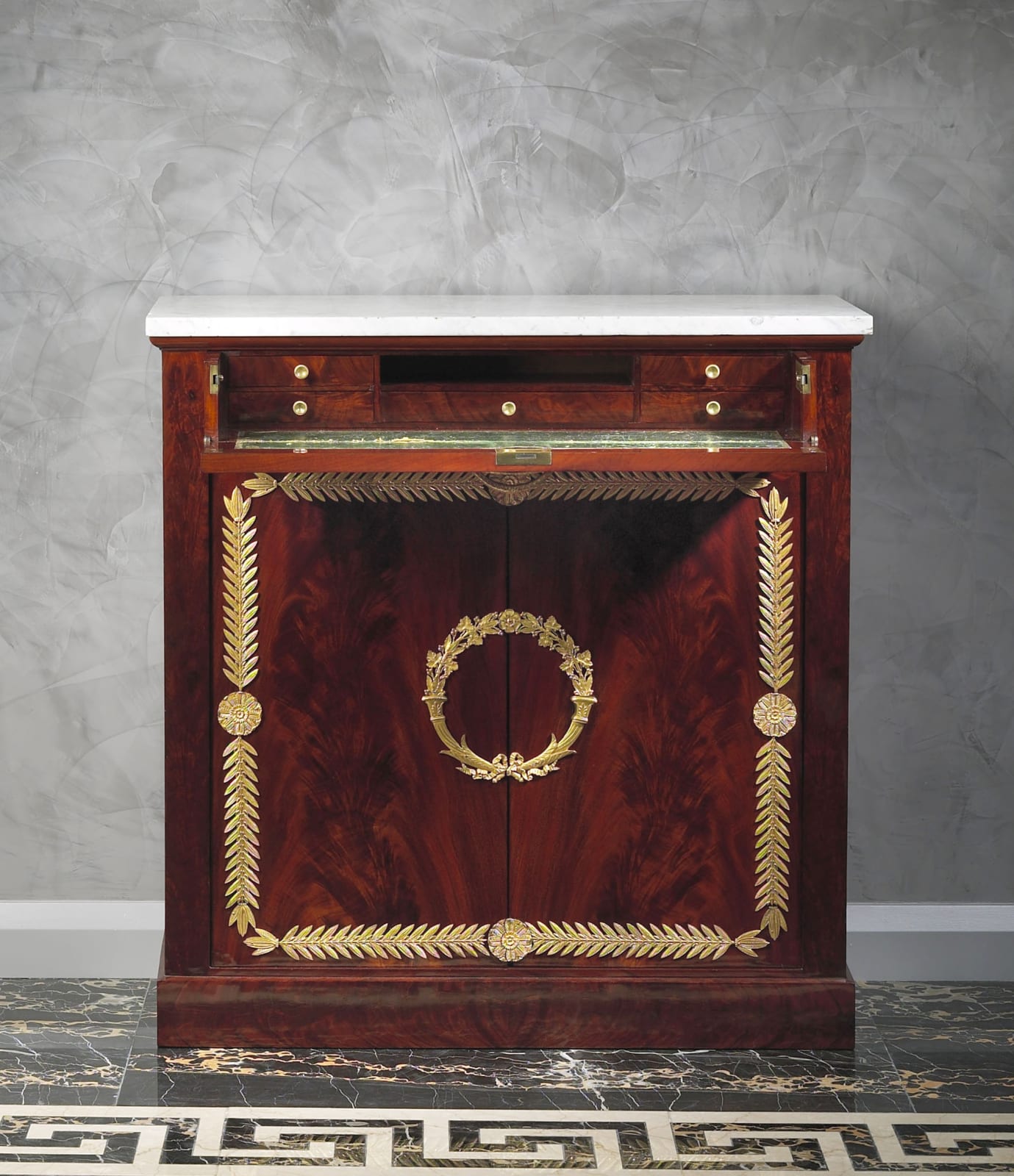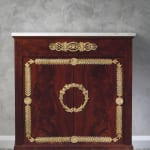Pierre-Benoît Marcion
Provenance
The Renty Family of Château de Choques, Lille until 1872.
Given by Madame de Renty to the person who looked after her husband. The son of the latter sold it 28th 1916 at rue des Petits Carnies. Purchased by the son-in-law [presumably of the latter], who purchased it and transported it using the firm Canelier de Alta [?] to Brussels the 7th 1916. Madame Beauthier (died 17th November 1947) at Château Grez-Doiceau, Brabant, who bequeathed it to her niece Madame Lambert, née Babut du Marès, who bequeathed the piece to her son, Georges Lambert.
One of the drawers of this handsome piece is inscribed with details of its history. Although some of the words are difficult to decipher
such a provenance greatly adds to its importance. Mention is made of Madame Beauthier, who died 17th November 1947; she was Marie Désirée Fortunée Henriette née Babut du Marès, who in 1900 married Edouard Beauthier, chatelaine of Grez-Doiceau in Brabant. Her niece was Marie Madeleine née Babut du Marès, who was born 3rd March 1902 and married Georges Lambert (1902-53), son of Georges Lambert and Berthe Lannoy. In turn the piece was left to their son who was also called Georges Lambert.
An extremely fine Empire gilt bronze mounted mahogany commode attributed to Pierre-Benoît Marcion, the rectangular grey veined white marble top above a long frieze drawer centred by a palmette and anthemion mount above two doors decorated with a rosette and laurel border and centred by a ribbon-tied wreath composed of a pair of ribbon-tied floral cornucopiae, the doors opening to reveal two adjustable shelves
Paris, date circa 1810
Height 97 cm, width 95 cm, depth 38 cm.
The work is attributed to the very important Empire ébéniste Pierre-Benoît Marcion (1769-1840), whose work for the Emperor Napoleon was second only to Jacob-Desmalter. As here Marcion tended to favour simple but robust forms and ornamented mahogany as well as gilt and painted pieces with bold mounts. Among favoured mounts were laurel borders, which also featured on a giltwood console supplied in 1806 for the cabinet intérieur de Sa Majesté at Fontainebleau. Equally relevant was his frequent use of cornucopia mounts, which sometimes appeared as very elaborate escutcheons, for example on a mahogany commode supplied in 1807 for the chamber du Petit Trianon (Musée du Château de Versailles) or as part of a decorative mount for a frieze on a console in the Musée du Château de Compiègne (both illustrated in Denise Ledoux-Lebard, "Le Mobilier Français du XIXe Siècle", 2000, p. 462).
Among numerous Imperial commissions Marcion supplied furniture for the Grand and Petit Trianon at Versailles, the Châteaux de Saint-Cloud, de Compiègne, Fontainebleau, L'Elysée, Rambouillet, the Palais des Tuileries, Château de Laeken and Monte Cavallo. Some of his work can still be found in their original situ, while other pieces are housed in notable private collections as well as the Musée de Luxembourg, the Mobilier National Paris, the Musée National du Chateaux de Pau and de Malmaison.
Born in Paris 1769, Marcion established a workshop with a showroom in 1798 at rue Neuve-des-Petits-Champs, which he called 'Aux Egyptiens'. There he advertised himself as supplying 'a choice of furniture, in mahogany, richly ornamented with bronzes after the beautiful forms of the ancient Etruscans, Egyptians, Greeks and Romans'. In 1801 Marcion moved to rue Helvetius and then from 1811-16 was based at rue de Choiseul. Marcion's career was relatively short, since when Napoleon was finally overthrown in 1815 many outstanding debts were still owed to him. He finally gave up his business in 1817 when he retired to Château-Thierry; he died 23 years later on 17th May 1840 at rue de l'Echiquier, Paris.



